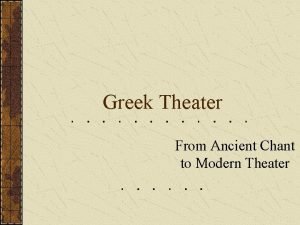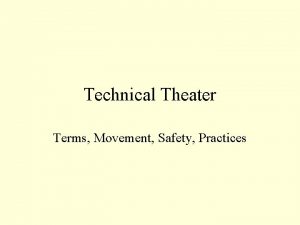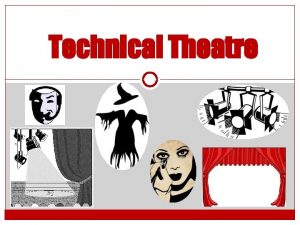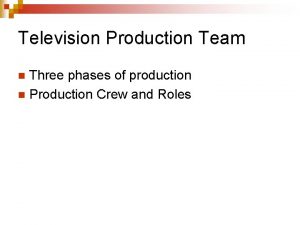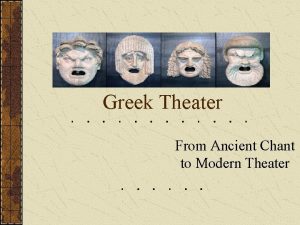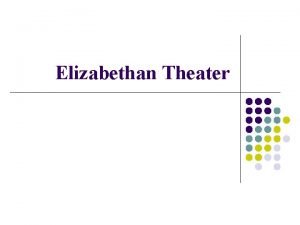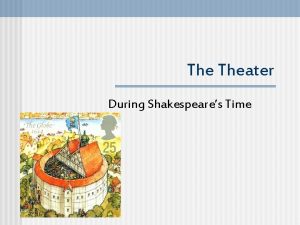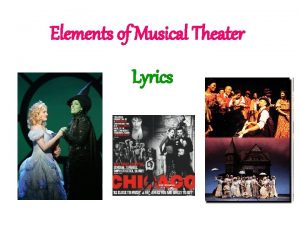TECHNICAL THEATER THE PRODUCTION TEAM MR SMITH THEATER














- Slides: 14

TECHNICAL THEATER: THE PRODUCTION TEAM MR. SMITH - THEATER ARTS

THE PRODUCTION TEAM • Every production relies on a small army of people who, although they don't appear on stage, are every bit as important to the success of the production as the cast. They build the set, design the costumes, provide for lights, and make sure the audience finds the show. • Without them, the cast would perform naked, in the dark, on a bare floor, in an empty room. They are The Production Team.

THE DIRECTOR • The Director is the leader of the Production Team and everyone involved in the show. He or she’s role is to bring the story to life onstage and oversee the Production Team to ensure the show is a success. • Theater directors hold auditions to select the acting cast members. They collaborate with the technical crew, which may consist of lighting, sound, set and costume designers. • The director blocks the play by adapting the actor movements to workable floor plans on the set. Leading rehearsals, he or she collaborates creatively with the actors and technical crew to make the blocking natural, changing it when necessary and allowing inspiration. • Actors draw out character motivations and relationships under the watchful eye of the director, who strives to develop these expressions over the performance's required transitions. Directors finish their work when they determine the final pacing of the play reverberates with the life of an artistic vision that is satisfying and complete.

THE ASSISTANT DIRECTOR • The Assistant Director is the Right Hand man/woman to the Director. The role of Assistant Director is at the discretion of the Director. • I give all paperwork including attendance, cast contracts, and parent volunteer forms to my Assistant Director. The Director should try to minimize their outside jobs as much as possible to focus on the creative direction of the show. • I also put my Assistant Director in charge of all advertising. This include flyers, tshirt, radio announcements, newspaper articles etc.

STAGE MANAGER/ASSISTANT STAGE MANAGER • The stage manager is present at all performances. He/she communicates remotely with technical crew and calls all cues for lighting and sound effects, as well as coordinating the run crew for any scene changes that may be called for. The stage manager also assists with the production from the start. The stage manager should try be present at every stage rehearsal (and music rehearsal, if possible!). During rehearsal, the stage manager should maintain order in the cast and record blocking notes for the Director. As production week approaches and the cast goes off book, the stage manager provides line cues when necessary. • One or more assistant stage managers can make the task much easier, especially in a show with a large cast. In addition, the job of rehearsal stage manager is sometimes split among several people, which works well as long as they keep in close communication with one another.

RUN CREW • The Run Crew performs set changes and other miscellaneous tasks as necessary during the show. • https: //www. youtube. com/watch? v=TFj. Ppk. Iq. KN 4

SET DESIGNER • The Set Designer takes a concept drawing or description from the Stage Director and produces a detailed design. He/she must work in close collaboration with the Lighting Designer and Master Carpenter, so that a feasible design is produced. The design must include color choices, but it is not necessary to go into more construction detail than simple elevations and suggested ideas for construction. • The Set Designer should also meet with the director in order to make sure that the design is consistent with the director's artistic concepts and can accomodate any technical needs that the direction may call for (for example if the director needs something for people to hide behind during a certain scene). • The Set Designer sometimes works with a Scenic Artist or Set Painter. In this case, the Scenic Artist would be someone with more interest in choosing colors and painting the scenic elements.

TECHNICAL DIRECTOR • The Technical Director (TD) is responsible for making sure that all technical aspects of a show are carried out in a timely fashion. This includes coordinating the set design, lighting and set construction, and handling any technical details needed during performances. Scheduling meetings, set building and put-in are the main tasks. A set and light crew must be recruited; this job may be delegated to the Master Carpenter and Lighting Designer/Master Electrician who will be supervising them, but it is ultimately the TD's responsibility to make sure that adequate manpower exists. • This job can be purely administrative if enough of the labor is delegated to the set and lighting crews, or it can be more hands-on. Once the set is put in and the lights are hung, the TD's job is essentially finished. If there are problems that the Master Carpenter, Lighting Designer, Master Electrician or Key Grip cannot handle, however, the TD must still be available to solve them.

COSTUME DESIGNER • The Costume Designer finds, makes, and/or coordinates costumes for the cast. He/she reports to the Technical Director, but should also communicate well with the director to ensure that the costumes are consistent with his/her concept of the show. Costume designing is a big job involving a lot of work, and the Costume Designer should attempt to get as much help as possible. The Costume Designer may also be called upon to provide makeup assistance. • For some shows, the costume designer may primarily select costumes from our stock, and locating others that can be borrowed or rented from other theater groups around MIT and the community. Usually a few costumes must be built from scratch, but the rest only need to be fitted to the actors. Other times, the costume designer may literally design most of the costumes to be worn on stage, and organize a team to sew them. In this case, it is helpful to have a Master Seamstress (or Stitcher, or Tailor) who manages the majority of the actual construction, and a large team of people to help. • The Costume Crew assists the Master Stitcher/Tailor/Seamstress in building the costumes for the show.

MAKE-UP ARTIST • The Makeup Artist is responsible for ensuring that we have the proper makeup for the cast, and that they know how to use it. The Makeup Artist usually implements special makeup effects (such as age or ghosts), while helping teach cast members how to do their own basic makeup. • https: //www. youtube. com/watch? v=Gayg. Hz. Xv. IWo

PROP MASTER • The Props Master is responsible for locating anything that will need to be carried by actors on stage. This may include weapons, bottles, luggage, wands, teapots, and anything else the director and cast may come up with. Many props can be found in our own props closet or borrowed from other theater groups or the cast. Sometimes some props will need to be made or built.

HOUSE MANAGER • The House Manager handles all aspects of the show relating to the audience. This includes ticket sales, seating issues, and refreshments.

CHOREOGRAPHER • The Choreographer is responsible for designing dances that may be needed and teaching them to the cast. Most of the dance we use should be fairly simple and easy to learn. The stage director will usually have a vision of what the dance should look like, where it should take place, and so on. The choreographer's responsibility is to make that vision happen on stage.

MUSIC DIRECTOR • The Music Director is in charge of teaching the cast all the music for the production as well as arranging the orchestra for the performances. • You will want someone with musical knowledge to conduct rehearsals and performances. Your accompaniment can be a full orchestra or one person at a piano. Some licensing firms now provide pre-recorded "rehearsal" accompaniment for certain shows – even if you use these recordings, your cast will benefit from having a capable musical director to guide them through the often terrifying prospect of singing on stage.
 Multimedia content production adalah
Multimedia content production adalah Greek theater vs modern theater
Greek theater vs modern theater Technical theater terms
Technical theater terms Technical theater vocabulary
Technical theater vocabulary This morning production team
This morning production team Tv production team
Tv production team 43 cfr 3174
43 cfr 3174 Multimedia team
Multimedia team The white team cheers for the blue team, just like
The white team cheers for the blue team, just like Bureaucratic bypass syndrome
Bureaucratic bypass syndrome Team spirit becomes team infatuation
Team spirit becomes team infatuation Một số thể thơ truyền thống
Một số thể thơ truyền thống Nguyên nhân của sự mỏi cơ sinh 8
Nguyên nhân của sự mỏi cơ sinh 8 Trời xanh đây là của chúng ta thể thơ
Trời xanh đây là của chúng ta thể thơ Voi kéo gỗ như thế nào
Voi kéo gỗ như thế nào

